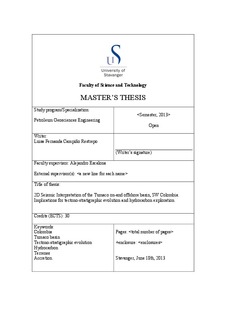| dc.contributor.author | Campiño Restrepo, Luisa Fernanda | |
| dc.date.accessioned | 2013-11-14T12:30:10Z | |
| dc.date.available | 2013-11-14T12:30:10Z | |
| dc.date.issued | 2013-06-14 | |
| dc.identifier.uri | http://hdl.handle.net/11250/183406 | |
| dc.description | Master's thesis in Petroleum geoscience engineering | no_NO |
| dc.description.abstract | The Tumaco on and offshore basin is located in the Pacific region of NW corner of South America, southwestern Colombia. It is classified as a forearc basin and it is considered a frontier exploration basin. The basin was formed during Paleogene-Recent convergence of oceanic derived terranes against South America. The stratigraphy consists of a volcano-clastic basement overlie by an Eocene to Recent clastic sedimentary cover. The last exploratory well, drilled in the 80’s, showed non-commercial amounts of oil and gas. This study integrates new onshore outcrop data (e.g. biostratigraphy, stratigraphic and organic geochemistry) with more than 3000 Km of 2D seismic data on- and offshore.
Results based on seismic interpretation, plate tectonic models and surface geology indicate that the basement high, the Remolinogrande high, is the continuation of the Gorgona large igneous province to the north, which was accreted in the Late Eocene during subduction of the Farallon plate beneath South America. This accretion resulted in the development of the Tumaco onshore basin, located between the Remolinogrande high and the Western Cordillera of Colombia.
The Tumaco offshore basin is suggested as the fore-arc basin that results of the subduction of the Nazca plate beneath South America. The subduction affected the entire region, resulting in continuous uplift of the Remolinogrande high and the migration of the fore-arc basin eastwards.
Two main geological terranes were identified. The Tumaco South terrane (Gorgona terrane sensu Cediel et al., 2003) and the Tumaco North terrane. These terranes are separated by the Garrapatas Fault System and exhibit two diferent deformation styles. The structural style in the Tumaco South terrane is characterized by a thick skin deformation while the Tumaco North terrane has a thin skin deformation.
vii
Eocene-Recent basin infill of the Tumaco onshore basin occurred mostly from the Western Cordillera of Colombia with the development of deep marine to continental deposition, whereas the Tumaco offshore consists of mostly marine sedimentation since Miocene. Source rocks mostly include gas prone Eocene marine shales in the Tumaco on - and off shore basin that are buried today to a depth of 8 km. Reservoir rocks include marine and continental sandstones of Miocene age.
Because the Tumaco basin has a sag type basin configuration most of the traps are pinchtouts against the uplifted Remolinogrande high and stratigraphic traps. | no_NO |
| dc.language.iso | eng | no_NO |
| dc.publisher | University of Stavanger, Norway | no_NO |
| dc.relation.ispartofseries | Masteroppgave/UIS-TN-IPT/2013; | |
| dc.subject | Colombia | no_NO |
| dc.subject | Tumaco basin | no_NO |
| dc.subject | Terrenes | no_NO |
| dc.subject | accretion | no_NO |
| dc.subject | petroleumsgeologi | no_NO |
| dc.subject | Tectono-stratigraphic evolution | no_NO |
| dc.subject | hydrocarbon | no_NO |
| dc.subject | geoscience | no_NO |
| dc.subject | petroleumsgeologi | |
| dc.title | 2D Seismic Interpretation of the Tumaco on-and offshore basin, SW Colombia. Implications for tectono-stratigraphic evolution and hydrocarbon exploration | no_NO |
| dc.type | Master thesis | no_NO |
| dc.subject.nsi | VDP::Technology: 500::Rock and petroleum disciplines: 510::Geological engineering: 513 | no_NO |
